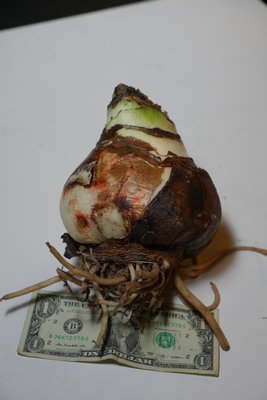

OK, plant mavens, here’s a spot quiz. What can be planted now and for the next four to six weeks that takes another eight to 10 weeks to bloom, has absolutely remarkable flowers, its roots in both Holland and South Africa and can be rebloomed every year? Another hint? It’s really easy to get it to bloom the first year, but if you can get it to bloom the second year—a little bit of a challenge—you’re an expert.The answer is the amaryllis, and it’s one of the largest bulbs you’ll ever plant. It’s also a misnomer—the true amaryllis is actually the species belladonna and it’s native to Cape Province in South Africa. It’s widely grown in warmer climates and can often be found in the landscapes of Florida and California, but up here it’s not hardy and rarely grown unless it’s lifted and stored indoors every year.
There’s yet another related plant we often refer as the “hardy amaryllis” or the Resurrection lily, Lycoris squamigera. This one sends up its foliage in the spring, then the leaves die to the ground by early in July. The plant then seemingly returns from the dead, sending up 2- to 3-foot stalks with rosy, amaryllis-like, sweet-scented flowers in August.
But the amaryllis that we’re most familiar with is actually Hippeastrum, which are primarily grown in Holland. There are about 90 species in this group and as many as 600 cultivars, but we grow only fewer than 50 of them as forced indoor plants. The bulbs are from 3 to 6 inches in diameter and are widely available through catalogs and at garden centers at this time of the year.
The glory of these bulbs are their spectacular flowers that sit atop 2- to 3-foot-tall, thick tubular stems in a wide range of flower colors and bi-colors, with the flower forms being single- or double-petaled. There are a few miniature varieties and some novelties as well, and as I’ve warned in the past, growing these can be a wonderfully addictive hobby that will brighten the dullest of winter days.
Just about anyone can grow this plant once. All you need to do is plant the bulb in a pot (though you can buy them pre-planted), give it some warmth and bright light, and about eight weeks after you “start” them they flower. The bulbs we purchase are in a dormant state and the warmth and moist soil will stimulate roots and stem growth. Usually the stems or stalk emerge first, but some foliage may develop from the bulb as well.
Flowering can last from two to three weeks and depending on the quality of the bulb, as in size, you should get two to four or more flowers the first year on each of the stems. Some flowers produce lots of pollen and if this is a problem simply cut off the anthers where the pollen forms and throw them away. As soon as the flowers fade, cut the flowers off—and now the fun begins. Huh?
This is where you get your horticultural challenge and gardener’s badge of merit. If you treat your amaryllis right, from this point onward it will flower again next year and for years to come. In fact, if you’re really good, your bulb will develop pups or tiny side bulbs that can be grown on and they in turn will flower … but not for several years.
So, you spent 15 to 20 bucks for a really special bulb—maybe a Dancing Queen, Royal Velvet or the more common Apple Blossom—and it performed as advertised and you want it to flower again next year. What to do?
After flowering you’ll notice several flat and narrow leaves emerging from the bulb. These leaves can get up to 18 inches long and they need plenty of bright light and daytime temperatures in the 70s. This foliage will remain until late next summer, when you’ll begin to cut back on the water and start forcing the bulb into dormancy. The plant can go outdoors in the summer—just make sure it doesn’t bake. From the time you cut the flowers off until next summer, the plant will need to be fed. The combination of the leaves being healthy and feeding the plants enables the next flower buds to form inside the bulb. The healthier the plant, the more magnificent the flowers will be next year.
The plant will need to be forced into dormancy, and it needs a dormant period of about six weeks when it gets no water and stays a bit cooler and out of the sun. A dark closet is perfect for this. After that six-week dormancy, the process begins all over again. The bulb stays in the same pot (they like to be tight), water is slowly added over a period of a couple of weeks, and in about nine to 10 weeks you should have your flowers back and the cycle has been completed. Now that you’ve been successful, you can do it all over again—and by all means buy more bulbs as you gain more confidence.
A couple of important things to remember in your glow of success. Count backward! Remember that your bulb will need a six-week dormant period, then eight to 10 weeks to flower. So if you want flowers in December, you need to have your bulbs dormant 16 weeks earlier, as in August. After a couple of years small bulbs or pups will develop on the side of your parent bulb. At the end of the summer these can easily be separated and potted up in small pots. A 1-inch bulb will mature and flower in about three years … but still needs to go through the same growing cycle with a dormant period.
If this is your first try, start out with maybe three bulbs and expect to pay $10 to $25 for each bulb. Look for bulbs 4 to 5 inches in diameter, and if you are shopping locally expect to find no more than a dozen varieties. If you shop online you can find up to 50 varieties at retailers like the White Flower Farm.
Instructions are easy to come by online for both growing and reblooming, but basically you want to plant in a pot that’s only about an inch in diameter larger than the bulb. Any good soilless potting mix will work, and I think you should stick to clay pots, as this reduces any risk from rotting if you’re heavy-handed on the watering. The bulbs should be planted high in the pot with about an inch or so of the bulb sitting above the soil.
I think these bulbs make great gifts, but it’s hard to find them at the holidays, though you may find some online retailers that will take your orders now and keep the bulbs dormant until December. And another word of caution. Amaryllis can be addictive. I started with one and my collection grew to over 40, when I had to go cold turkey or get thrown out of the house. But what a great way to go. Keep growing.
 More Posts from Andrew Messinger
More Posts from Andrew Messinger